While the Bald Eagle (Haliaeetus leucocephalus) is an iconic bird known for its distinctive white head and powerful presence, there are several other bird species that share similar characteristics and may resemble Bald Eagles at first glance. One such bird is the Golden Eagle (Aquila chrysaetos), which also has a large wingspan, brown body, and a similar hooked beak.
Another species that bears resemblance is the Osprey (Pandion haliaetus), commonly known as the Fish Hawk, with its brown and white plumage and a sharp curved beak for hunting fish. Additionally, the Steller’s Sea Eagle (Haliaeetus pelagicus) from northeast Asia exhibits a white head and massive size akin to the Bald Eagle. Although these birds may resemble the Bald Eagle, each species has its own unique characteristics and habitats.
Bald Eagle


| Feature | Measurement |
|---|---|
| Scientific Name | Haliaeetus leucocephalus |
| Length | 70–102 cm (28–40 in) |
| Wingspan | 1.8 and 2.3 m (5 ft 11 in and 7 ft 7 in) |
| Weight | 3 and 6.3 kg (6.6 and 13.9 lb) |
The Bald Eagle is a bird of prey native to North America, most recognizable for its striking features: a white head and tail contrasted by a dark brown body. This raptor primarily feeds on fish, which it catches with its strong, sharp talons. Bald Eagles are renowned for their impressive flight skills and can reach high speeds in the air.
Their nests, or eyries, are some of the largest of any bird species, often built near bodies of water in tall trees or cliffs for an optimal view of their surroundings. Bald Eagles have a significant cultural status in the United States, serving as the national bird and a symbol of freedom.
Birds That Look Like Bald Eagles
Eagles: There are 3 species of eagles that look like bald eagles:
- African Fish Eagles
- White-tailed Eagles
- Golden Eagle
Hawks: There are 5 species of hawks that resemble bald eagles:
- Red-Tailed Hawk
- Northern Goshawk
- Cooper’s Hawk
- Ferruginous Hawk
- Northern Harrier
Vultures: There are 3 species of vultures that can be mistaken for bald eagles:
- Turkey Vulture
- Black Vulture
- Andean Condor
Ospreys: The Western Osprey is the only osprey species that resembles a bald eagle.
Falcons: The Prairie Falcon is the only falcon that looks like a bald eagle.
Kites: The Black Kite is the only kite species that can be mistaken for a bald eagle.
African Fish Eagle


| Feature | Measurement |
|---|---|
| Scientific Name | Haliaeetus vocifer |
| Length | 25–29.5 in |
| Wingspan | 6.6 ft – 7.9 ft |
| Weight | 2 – 3.6 kg |
The African Fish Eagle is a majestic bird of prey found in sub-Saharan Africa. This iconic bird is known for its distinctive white head, chestnut body, and dark brown feathers. It derives its name from its strong affinity for fish, which constitutes a significant part of its diet. African Fish Eagles are skilled hunters, often soaring above lakes, rivers, and wetlands, scanning for fish near the water’s surface.
Similarities
- The African Fish Eagle and the Bald Eagle, both raptors, share a distinct predatory physique, including broad wings, powerful beaks, and sharp talons. Their partiality towards a piscivorous diet gives them similar hunting behaviors.
- Visually, they share striking color similarities: both species have a dark brown body contrasted with a white head and tail.
Differences
- The Bald Eagle is larger, with a wingspan reaching over 7 feet, while the African Fish Eagle’s wingspan averages about 6 feet.
- The Bald Eagle’s head and tail are pure white, while the African Fish Eagle displays a light brown “halo” on the nape and a more chestnut hue on the wings and body.
- The African Fish Eagle is primarily found around freshwater habitats across Sub-Saharan Africa, whereas the Bald Eagle is prevalent across North America.
White-tailed Eagle


| Feature | Measurement |
|---|---|
| Scientific Name | Haliaeetus albicilla |
| Length | 66 to 94 cm (26 to 37 in) |
| Wingspan | 1.78 to 2.45 m (5 ft 10 in to 8 ft 0 in) |
| Weight | Male: 3.1 to 5.4 kg (6.8 to 11.9 lb)/ Female: 4 to 6.9 kg (8.8 to 15.2 lb) |
The White-tailed Eagle is a magnificent bird of prey that can be found throughout northern Europe and Asia. It’s easily identified by its broad wings, heavy body, and the characteristic pale tail that gives it its name. It’s an adept hunter and scavenger, feeding primarily on fish and waterfowl, but not averse to carrion. White-tailed Eagles prefer habitats near large bodies of water where they can find ample food. Their nests, or eyries, are generally built in high cliffs or large trees and can be reused year after year. They’re known for their slow and graceful flight, often seen soaring high in the sky in wide circles.
Similarities
- White-tailed Eagles and Bald Eagles, both members of the sea and fish eagle genus (Haliaeetus), share characteristic features. They possess large, sturdy bodies, broad wings, and robust, hooked beaks.
- Their talons are sharp and strong for hunting and capturing prey. Both species display a combination of dark and white plumage, making them visually striking.
Differences
- The Bald Eagle is known for its dark brown body contrasted by a white head and tail, whereas the White-tailed Eagle, although also brown-bodied, has a paler, almost bleached appearance.
- The latter’s tail, true to its name, is white but it lacks the bald eagle’s white head.
- Size-wise, the White-tailed Eagle slightly surpasses the Bald Eagle with a wingspan that can reach over 8 feet, compared to the Bald Eagle’s 7 feet.
Golden Eagle


| Feature | Measurement |
|---|---|
| Scientific Name | Aquila chrysaetos |
| Length | 66 to 102 centimetres (26 to 40 in) |
| Wingspan | 1.8 to 2.34 metres (5 ft 11 in to 7 ft 8 in) |
| Weight | 4.05 and 6.35 kg (8.9 and 14.0 lb) |
The Golden Eagle is a powerful raptor found across the Northern Hemisphere, known for its impressive agility and speed in flight. Its name comes from the beautiful golden feathers that adorn the back of its head and neck. These birds of prey are versatile hunters, feeding on a wide range of animals including rabbits, squirrels, and even larger prey like foxes and young deer.
Preferred habitats are typically in mountainous regions, but they can also be found in a variety of environments including deserts and plains. Golden Eagles are solitary creatures, often found alone or in pairs, and they build their nests, or eyries, high on cliff faces or in tall trees.
Similarities
- The Golden Eagle and the Bald Eagle, as apex predators, share several characteristics. Both have broad wings, sturdy bodies, and strong, hooked beaks adapted to their carnivorous diets. They possess sharp talons for hunting and are capable of impressive aerial maneuvers. These eagles are known for their long lifespan, often reaching several decades in the wild.
Differences
- Despite these shared traits, the Golden Eagle and the Bald Eagle differ in size and distinct visual features. The Bald Eagle is slightly larger, with a wingspan that can exceed 7 feet, compared to the Golden Eagle’s wingspan that averages around 7 feet. In terms of appearance, the Bald Eagle is characterized by its dark brown body and white head and tail feathers. In contrast, the Golden Eagle has a more uniform dark brown coloration throughout, with golden-brown plumage on the back of its head and neck, giving it its name.
Red-Tailed Hawk

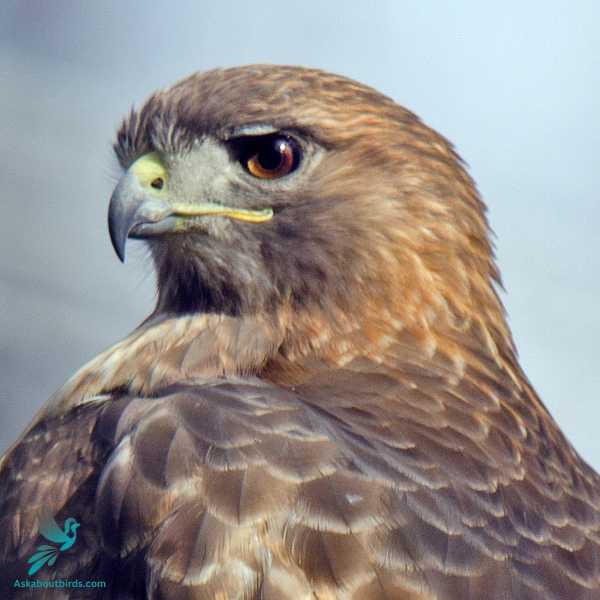
| Feature | Measurement |
|---|---|
| Scientific Name | Buteo jamaicensis |
| Length | 45–65 cm (18–26 in) |
| Wingspan | 110–141 cm (3 ft 7 in – 4 ft 8 in) |
| Weight | 690 to 1,600 g (1.5 to 3.5 lb) |
The Red-Tailed Hawk is a bird of prey that is commonly found across North America. This adaptable raptor is known for its brick-red tail, which is most noticeable in adults from above or underneath. The diet of the Red-Tailed Hawk is very diverse, including small mammals like mice and squirrels, as well as birds and reptiles.
This hawk is often seen perched on poles or soaring in wide circles high above fields, forests, and highways. Its habitat is extremely varied, ranging from desert and scrublands to forests and tropical rainforests. Its call, a raspy, screaming kee-eeeee-arr, is often used in movies to represent any bird of prey.
Similarities
- The Red-Tailed Hawk and the Bald Eagle, both raptors, exhibit similar physical attributes that aid in their predatory lifestyle. They possess broad wings, sharp beaks, and strong talons that allow them to catch and devour prey. Both birds also have a sturdy body structure built for flight and predatory behaviors.
Differences
- Differences between the Red-Tailed Hawk and the Bald Eagle are noticeable in terms of size and coloration. The Bald Eagle is considerably larger, boasting a wingspan that exceeds 7 feet, compared to the Red-Tailed Hawk’s more modest wingspan of approximately 4.5 feet. The Bald Eagle is identified by its dark brown body contrasted with a white head and tail, whereas the Red-Tailed Hawk is generally brown with a distinctive reddish-brown tail, from which it gets its name.
Northern Goshawk

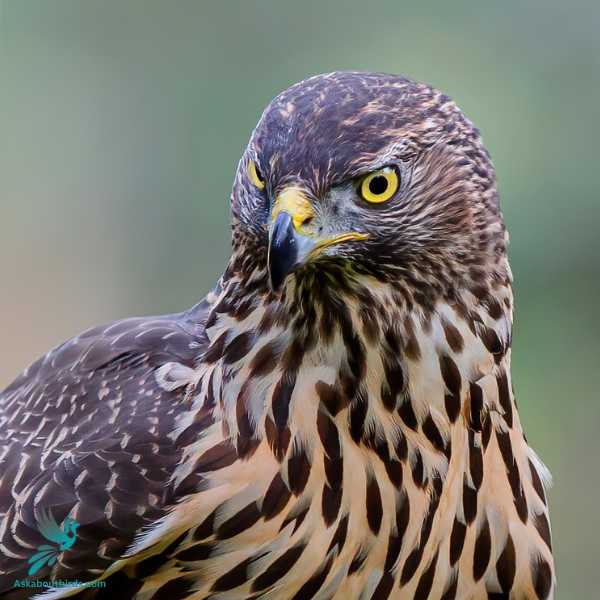
| Feature | Measurement |
|---|---|
| Scientific Name | Accipiter gentilis |
| Length | Male: 46 to 61 cm (18 to 24 in) / Female: 58 to 69 cm (23 to 27 in) |
| Wingspan | 89 to 105 cm (35 to 41 in)/ Female: 108 to 127 cm (43 to 50 in) |
| Weight |
The Northern Goshawk is a large bird of prey and the largest member of the Accipiter genus. Native to the Northern Hemisphere, it’s characterized by its slate-gray upperparts, finely barred underparts, and prominent white eyebrow stripe. The name “goshawk” originates from the Old English term for “goose hawk,” denoting the bird’s prowess at hunting large prey.
Northern Goshawks inhabit large, uninterrupted forests, where they are skilled hunters of a wide range of prey, including small mammals and medium to large birds. They are particularly agile fliers, often chasing prey through densely forested environments. These hawks are monogamous, with pairs often returning to the same nesting territory year after year. Their nests are built high in trees, and their breeding season is heralded by spectacular aerial displays and a loud, repetitive ‘kak-kak-kak’ call.
Similarities
- The Northern Goshawk and the Bald Eagle, both formidable raptors, share several common characteristics that align with their predatory lifestyles. These traits include broad wings, robust bodies, and sharp, hooked beaks.
- Both species have strong, sharp talons to grasp and dispatch their prey effectively. Their presence signifies a healthy ecosystem due to their position as apex predators.
Differences
- The Bald Eagle is much larger, with a wingspan reaching over 7 feet, compared to the Northern Goshawk’s smaller wingspan of about 3.5 feet.
- Color-wise, the Bald Eagle is characterized by its dark brown body contrasted with a white head and tail. The Northern Goshawk, however, has a more uniform gray-blue coloration with distinctive white eyebrows, and its underside displays fine, horizontal barring.
Cooper’s Hawk

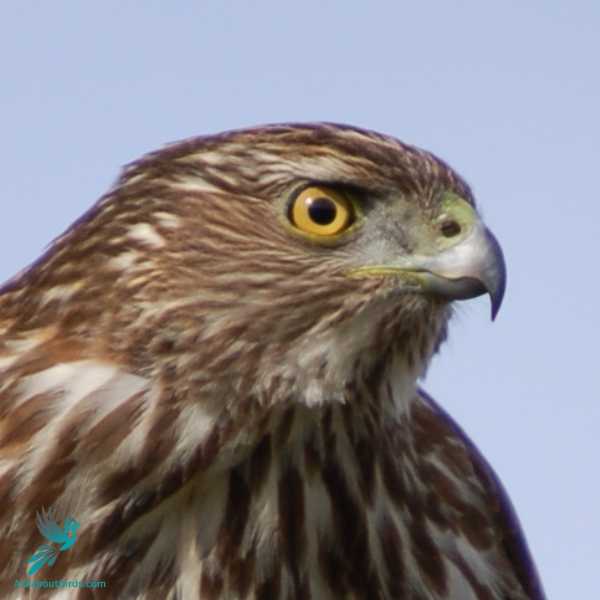
| Feature | Measurement |
|---|---|
| Scientific Name | Accipiter cooperii |
| Length | 35 to 46 cm (14 to 18 in) /Female: 42 to 50 cm (17 to 20 in) |
| Wingspan | 62 to 99 cm (24 to 39 in) |
| Weight | Male: 280 g (9.9 oz) in 48/ Female: 473 g (1.043 lb) |
Cooper’s Hawk is a medium-sized bird of prey in the Accipiter genus, native to the North American continent. It’s named after the American naturalist William Cooper, and distinguished by its slate-gray back, red-barred chest, and rounded tail with broad white terminal band. It is similar in appearance to the smaller Sharp-shinned Hawk, but can be differentiated by its larger size and rounded tail.
Inhabiting various types of woodland and forests, Cooper’s Hawks are agile predators known for their skill at chasing birds through trees, their primary prey being small to medium-sized birds. They also feed on small mammals and, less commonly, reptiles. They’re noted for their explosive flight pattern, consisting of a few rapid wingbeats followed by a short glide. Cooper’s Hawks nest in trees, and both parents share duties of incubating the eggs and raising the young. Their call is a distinctive, repetitive ‘cak-cak-cak’, often heard during courtship or when disturbed.
Similarities
- They are known for their impressive hunting abilities, marked by strong, sharp talons and robust beaks.
- Both birds exhibit a powerful body structure, characterized by broad wings that allow them to soar and hunt efficiently in their respective environments.
Differences
- The Bald Eagle, being a much larger bird, boasts a wingspan over 7 feet, whereas the Cooper’s Hawk has a more modest wingspan of about 3 feet.
- The Bald Eagle’s dark brown body is contrasted by its iconic white head and tail, making it instantly recognizable. Conversely, the Cooper’s Hawk is smaller and sleeker, with a gray-blue back and top of the head, a characteristic long, banded tail, and barred underparts.
Ferruginous Hawk

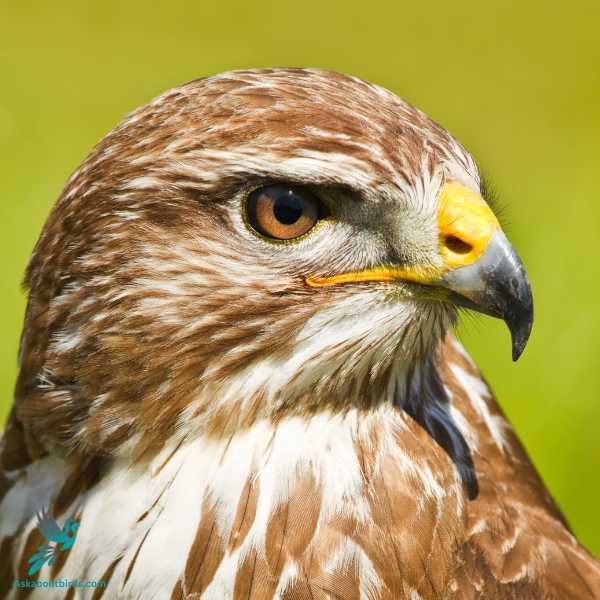
| Feature | Measurement |
|---|---|
| Scientific Name | Buteo regalis |
| Length | 51 to 69 cm (20 to 27 in) |
| Wingspan | 122 to 152 cm (48 to 60 in) |
| Weight | 907 to 2,268 g (32.0 to 80.0 oz) |
The Ferruginous Hawk is a large raptor native to the open landscapes of North America. The term “ferruginous” comes from the Latin word for rust, referring to the bird’s reddish-brown coloration. Ferruginous Hawks are primarily known for their size, broad wings, and a distinctive leg feathering that extends to the toes, a feature that makes them the most “feather-legged” of the North American hawks. This bird feeds primarily on mammals like rabbits and prairie dogs, but will also eat birds and reptiles. They thrive in open habitats such as prairies, plains, and deserts, where they often perch on the highest point available. Their nests are typically constructed on cliffs, trees, or man-made structures and are quite large, reflecting the size of the bird itself. Despite their intimidating presence, Ferruginous Hawks are generally more docile than other raptors.
Similarities
- Both the Ferruginous Hawk and the Bald Eagle belong to the raptor family, sharing similar characteristics that aid in their predatory behaviors. They possess broad wings, sharp beaks, and strong talons that facilitate their hunting abilities. Their sturdy body structures are adapted for flight and efficient prey capture.
Differences
- Despite these similarities, the Ferruginous Hawk and the Bald Eagle differ considerably in size and visual identification. The Bald Eagle is much larger, boasting a wingspan that exceeds 7 feet, compared to the Ferruginous Hawk’s wingspan of roughly 4.5 feet. The Bald Eagle is known for its dark brown body and contrasting white head and tail. On the other hand, the Ferruginous Hawk gets its name from its rust-colored back and shoulders and is lighter on the underside, with leg feathers extending to its talons, a feature uncommon in most hawk species.
Northern Harrier

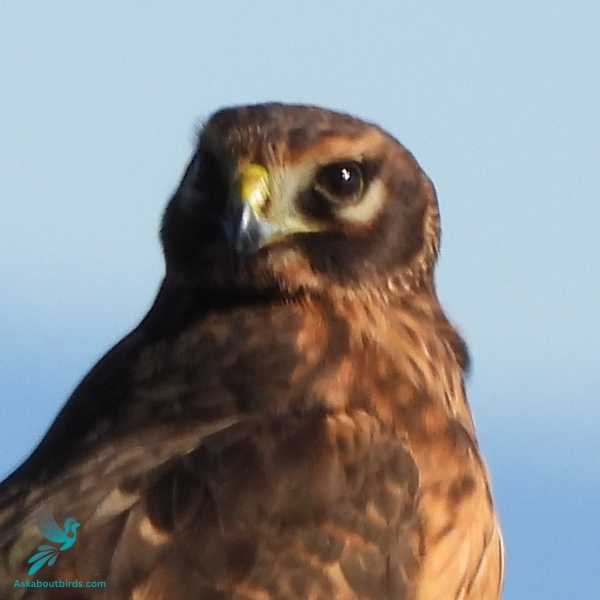
| Feature | Measurement |
|---|---|
| Scientific Name | Circus hudsonius |
| Length | 41–52 cm (16–20 in) |
| Wingspan | 97–122 cm (38–48 in) |
| Weight | Male 10 to 26 ounces (280 to 730 g) Female: 11 to 30 ounces (310 to 850 g) |
The Northern Harrier is a bird of prey that belongs to the Circinae subfamily and stands out due to its distinctively owl-like facial disk, slender body, and long tail. This species exhibits a low and slow flying pattern when hunting, often skimming just above the ground of open fields and marshes. The males are predominantly gray, while the females and young are brown with streaks of white.
Northern Harriers primarily feed on small mammals and birds. Unique among hawks, these birds possess an owl-like trait of using auditory cues as well as visual ones to locate and catch prey. They’re also known for their polygynous breeding system, where a male may have up to five mates at once, each nesting in different locations within his territory.
Similarities
- Both the Northern Harrier and the Bald Eagle are classified as birds of prey. They are skilled hunters and have adaptations that make them efficient predators.
- Both species employ similar hunting techniques, such as soaring and gliding over open areas in search of prey. They rely on their keen eyesight to spot potential targets from a distance.
- Although their habitats may differ to some extent, there is an overlap in the range of the Northern Harrier and the Bald Eagle. They can be found in various regions of North America and may occasionally share similar ecosystems.
Differences
- he Bald Eagle is significantly larger than the Northern Harrier. While the Bald Eagle has a wingspan that can exceed 6 feet and weighs around 8-14 pounds, the Northern Harrier has a smaller wingspan of about 3-4 feet and weighs around 10-26 ounces.
- The Bald Eagle has a distinctive white head and tail, while the Northern Harrier has a more mottled brown plumage.
- The Bald Eagle builds large, conspicuous nests, often in tall trees near bodies of water. These nests are reused and expanded over several years and can reach massive sizes. In contrast, the Northern Harrier nests on the ground, typically in grassy or marshy areas, creating a shallow depression or scrape lined with grass or other vegetation.
Turkey Vulture

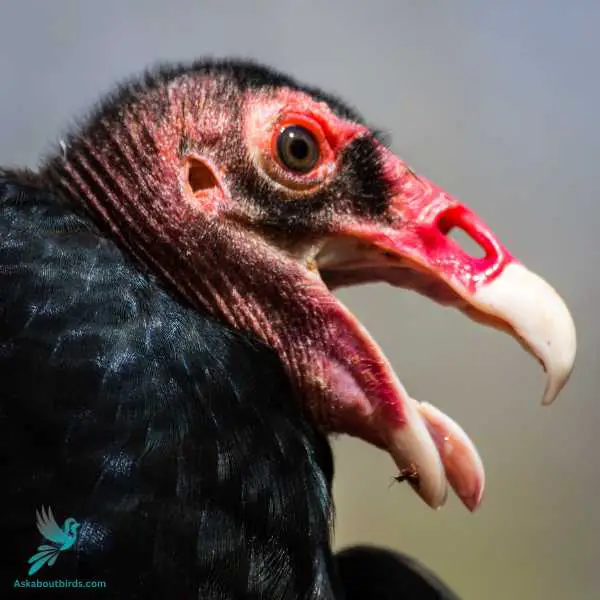
| Feature | Measurement |
|---|---|
| Scientific Name | Cathartes aura |
| Length | 62–81 cm (24–32 in) |
| Wingspan | 160–183 cm (63–72 in) |
| Weight | 0.8 to 2.41 kg (1.8 to 5.3 lb) |
The Turkey Vulture is a large bird commonly found throughout the Americas. It’s known for its dark body, featherless red head, and its large wingspan which enables extended periods of soaring flight. Unlike most birds of prey, the Turkey Vulture has a keen sense of smell, which it uses to locate carrion, its primary food source. It is often seen flying low to the ground in open areas or circling high in the sky, holding its wings in a distinctive V-shape, known as a dihedral angle. The Turkey Vulture roosts in large communal groups, often in trees or on rock ledges. This bird has an unusual method of self-defense: when threatened, it will regurgitate its meal, which is usually enough to deter most predators. Despite their somewhat grisly dietary habits, Turkey Vultures play an essential role in ecosystems by cleaning up dead animals.
Similarities
- Both the Turkey Vulture and the Bald Eagle have impressive wingspans. The average wingspan of a Turkey Vulture ranges from 5.5 to 6.6 feet (1.7 to 2 meters), while the Bald Eagle’s wingspan can reach up to 6.5 to 7.5 feet (2 to 2.3 meters).
- Both species are known to be carrion feeders, meaning they primarily scavenge on dead animals. Turkey Vultures and Bald Eagles have adaptations that allow them to locate carrion from long distances and consume decaying flesh.
- While the Bald Eagle is classified as a raptor or bird of prey, the Turkey Vulture is considered a New World vulture.
Differences
- The Turkey Vulture has a distinct appearance with dark brown or black plumage and a featherless red head. In contrast, the Bald Eagle displays a distinctive white head and tail, with a dark brown body and wings. The difference in plumage makes the Bald Eagle more easily recognizable.
- The Turkey Vulture primarily relies on its highly developed sense of smell to locate carrion, whereas the Bald Eagle relies more on its sharp eyesight and often steals or scavenges from other predators or scavengers.
- The Turkey Vulture is more commonly found in the Americas and has a broader distribution, ranging from southern Canada to South America. On the other hand, the Bald Eagle is primarily found in North America, with its range extending from Alaska and Canada down to northern Mexico.
Black Vulture

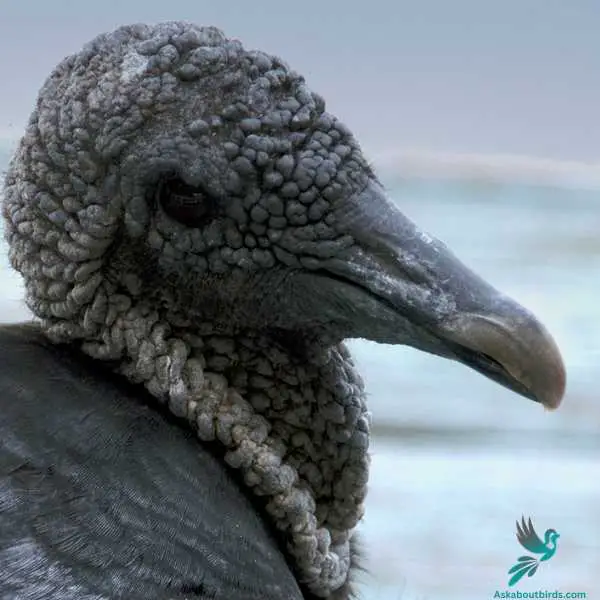
| Feature | Measurement |
|---|---|
| Scientific Name | Coragyps atratus |
| Length | 56–74 cm (22–29 in) |
| Wingspan | 1.33–1.67 m (52–66 in) |
| Weight | 1.6 to 3 kg (3.5 to 6.6 lb) |
The Black Vulture, native to the Americas, is a large bird recognized by its black plumage, featherless gray-black head, and short, hooked beak. Unlike the Turkey Vulture, the Black Vulture lacks a keen sense of smell and instead relies heavily on its vision to find food. Known for being a scavenger, it feeds almost exclusively on carrion, often locating meals by watching other vultures. Black Vultures are known to be more aggressive than their Turkey Vulture counterparts, sometimes even driving them away from a carcass. They are highly social birds and often seen in large groups, both while feeding and when roosting. Their flight pattern is distinctive, characterized by a series of quick flaps followed by a glide. In flight, the short, broad wings show large white patches at the tips, which can be used to identify them.

Similarities
- Both the black vulture and the bald eagle are large birds known for their impressive presence in the sky. They each have distinctive white and dark contrast in their plumage, which aids in their identification. In flight, they exhibit broad wings, allowing them to glide for extended periods.
- Both species are found across North and South America, though their specific habitats may vary. Moreover, these two bird species are scavengers, often feeding on carrion, thus playing crucial roles in their respective ecosystems by cleaning up dead animals and preventing the spread of disease.
- Both the Black Vulture and the Bald Eagle have impressive wingspans. The average wingspan of a Black Vulture ranges from 5.5 to 6.5 feet (1.7 to 2 meters), while the Bald Eagle’s wingspan can reach up to 6.5 to 7.5 feet (2 to 2.3 meters).
Differences
- Bald eagles are recognized for their white head and tail feathers against a dark brown body, whereas black vultures have a mostly black body with a contrasting white patch on the underside of their wings.
- In terms of size, bald eagles are typically larger, with wingspans reaching up to seven feet compared to the black vulture’s five to six feet. bbald eagles have strongly hooked beaks adapted for tearing flesh and fish, while black vultures have a less pronounced beak. bald eagles, being raptors, also hunt live prey such as fish and small mammals, unlike black vultures which feed primarily on carrion.
Andean Condor
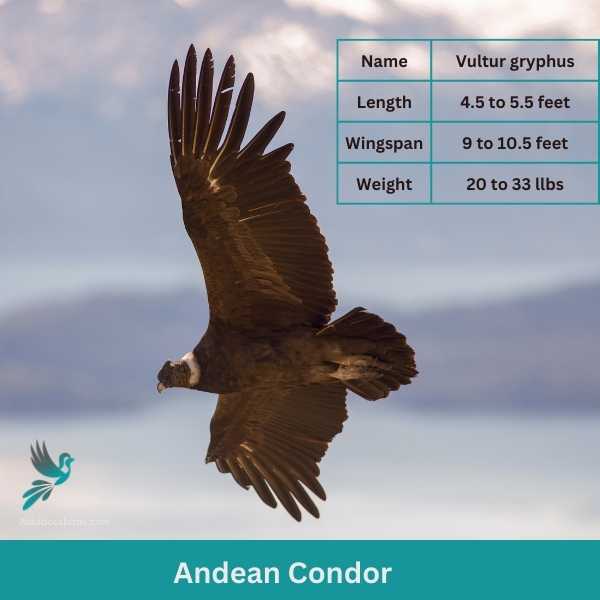

| Feature | Measurement |
|---|---|
| Scientific Name | Vultur gryphus |
| Length | 4.5 to 5.5 feet |
| Wingspan | 9 to 10.5 feet (2.7 to 3.2 meters) |
| Weight | 20 to 33 pounds (9 to 15 kilograms). |
The Andean Condor, one of the world’s largest flying birds, is a significant symbol in Andean cultures. Found in the mountain ranges of South America, this bird is easily recognized by its large size, black body, white collar of feathers around the neck, and large, bald head that can change color based on the bird’s emotional state. It is a scavenger by nature, feeding primarily on carrion, and is known to fly vast distances in search of food. The Andean Condor spends much of its time soaring on air currents high in the sky, using its massive wings, which provide the lift needed for it to stay aloft with minimal effort. They nest on inaccessible rock ledges up to 5,000 meters high. Given their long lifespan, which can be over 70 years in captivity, and their slow rate of reproduction, they are particularly susceptible to human impacts, making conservation efforts vital for this species.
Similarities
- Both the Black Vulture and the Bald Eagle have impressive wingspans. The average wingspan of a Black Vulture ranges from 5.5 to 6.5 feet (1.7 to 2 meters), while the Bald Eagle’s wingspan can reach up to 6.5 to 7.5 feet (2 to 2.3 meters).
- Both species are scavengers and play important roles in their ecosystems by consuming carrion. They are equipped with sharp eyesight and are capable of spotting and locating carcasses from afar.
Differences
- The Black Vulture has predominantly black plumage and a featherless, wrinkled black head. In contrast, the Bald Eagle exhibits a distinctive white head and tail, with a dark brown body and wings. The difference in coloration and feather coverage makes them visually distinct.
- The Black Vulture is mainly found in the Americas, ranging from the southeastern United States down to South America. It tends to inhabit open areas, forests, and urban environments.
Osprey

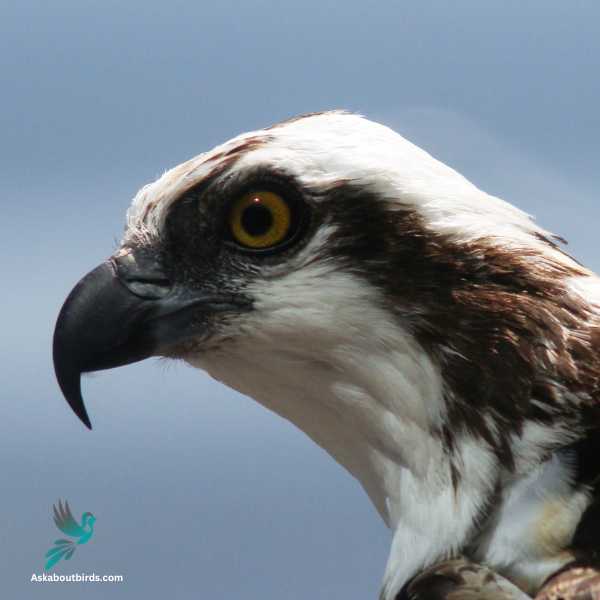
| Feature | Measurement |
|---|---|
| Scientific Name | Pandion haliaetus |
| Length | 50–66 cm (19.5 – 26 in) |
| Wingspan | 127–180 cm (50 – 71 in) |
| Weight | 2 lb 0 oz – 4 lb 10 oz) |
The Osprey, is a unique bird of prey found almost worldwide. It’s distinct for its diet, as it feeds almost exclusively on fish, diving feet-first to catch its prey in bodies of water. This bird is easily identifiable by its dark brown back, contrasting with its white underparts and head, and a distinctive dark eye-stripe that extends to the sides of the neck.
Ospreys are known for their incredible ability to hover in the air while locating fish below, before plunging into the water for the catch. Their nests, made of sticks and lined with softer material, are usually built in open surroundings for easy approach, often on top of trees, poles, or platforms specifically designed to encourage Osprey habitation.
Similarities
- The Western Osprey and the Bald Eagle share several similarities, primarily in their diet and hunting behavior. Both species are fish-eating birds of prey, equipped with sharp talons and hooked beaks for catching and consuming fish.
- They are known for their spectacular hunting dives, in which they plunge feet-first into water to capture fish.
- Both species are migratory, changing locations with the seasons, and are monogamous, usually mating for life.
Differences
- The Bald Eagle, being larger, has a wingspan that can reach over 7 feet, whereas the Osprey’s wingspan generally spans around 5 to 6 feet.
- Bald Eagles have a more diverse diet and are known to consume birds, mammals, and carrion.
- The Bald Eagle is distinguished by its dark brown body and white head and tail, while the Osprey has a white underside, a dark brown back, and a characteristic dark “mask” across its eyes.
Prairie Falcon

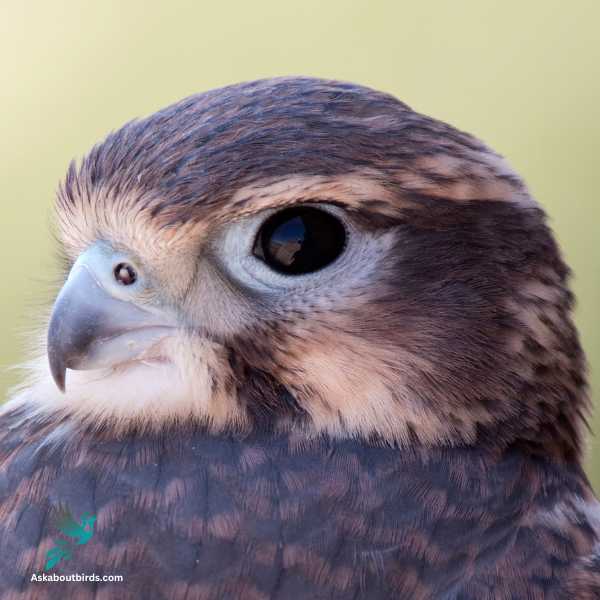
| Falco mexicanus | Measurement |
|---|---|
| Scientific Name | Falco mexicanus |
| Length | 37 to 38 cm (15 inches)/ Female: 45 cm (17.7 inches) |
| Wingspan | 1.1 meters (3.5 feet) |
| Weight | 500 to 635g (1.1 to 1.4 lbs)/Female: 762 to 970g (1.7 to 2.1 lbs) |
The Prairie Falcon is a raptor found in the open landscapes of western North America. Its appearance is often compared to the Peregrine Falcon, though it is generally smaller and has a lighter coloration with a cream to gray-brown body and darker wingtips. The Prairie Falcon is a powerful hunter, preying on small mammals and birds, which it catches in mid-air or on the ground after a high-speed chase. Unlike many other raptors, it often hunts in the heat of the day. The preferred habitats of this bird are deserts, grasslands, and the shrubby areas of the Great Plains, which reflect its name. Their nests are usually scraped out on cliff ledges. Known for their aggressive nature, Prairie Falcons will fiercely defend their nests against intruders.
Similarities
- Both have robust bodies, broad wings, and strong, sharp talons indicative of their predatory nature.
- They have sharply hooked beaks, designed for tearing their prey apart. These characteristics define them as birds of prey and signal their predatory lifestyle.
Differences
- The Bald Eagle is much larger, with a wingspan reaching over 7 feet, compared to the Prairie Falcon’s smaller wingspan of around 3 feet.
- Bald Eagles are known for their iconic dark brown bodies and contrasting white head and tail feathers. On the other hand, Prairie Falcons are generally a uniform sandy brown color, with darker streaks and a distinctive “moustache” marking that helps to distinguish them from other falcons.
Black Kite
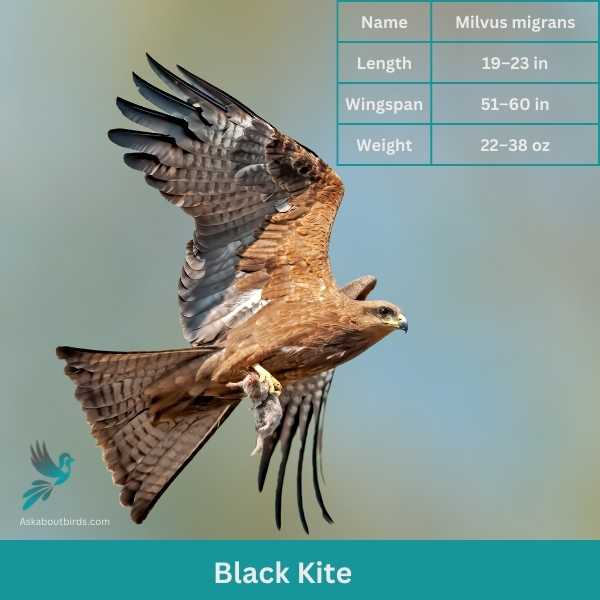
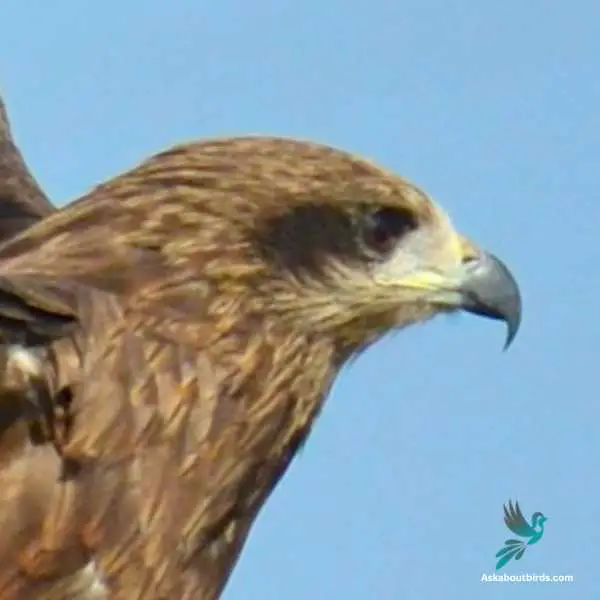
| Feature | Measurement |
|---|---|
| Scientific Name | Milvus migrans |
| Length | 48–58 cm (19–23 in) |
| Wingspan | 130–155 cm (51–60 in) |
| Weight | 560–940 g (22–38 oz) |
The Black Kite is a medium-sized bird of prey that can be found in regions all over the world, from Europe and Asia to Australia and parts of Africa.
Appearance: Black Kites are predominantly brown with a dark rufous coloration on the back of their heads and necks. They have a forked tail, which differentiates them from other types of kites, and their wingtips are black, which give them their name and they have yellow legs. Juveniles have lighter and more mottled plumage than adults.
Diet: These birds are opportunistic hunters and are known to eat a wide variety of foods, from fish and small mammals to carrion and invertebrates. They can also frequently be seen scavenging near human habitations.
Reproduction: Black Kites typically nest in tall trees, where they build large, untidy nests out of sticks and lined with softer materials. Females typically lay 2 to 3 eggs, which are incubated for about 30-32 days.
Similarities
- Both the Black Kite and the Bald Eagle exhibit dark coloration in their plumage. The Black Kite has predominantly dark brown or black feathers, while the Bald Eagle showcases a dark brown body and wings, often with a white head and tail.
- While the Bald Eagle is larger overall, both the Black Kite and the Bald Eagle have similar body shapes and proportions. They have broad wings and a streamlined body structure that aids in their flight capabilities.
Differences
- The Bald Eagle is significantly larger than the Black Kite. The Bald Eagle has an average wingspan of 6.5 to 7.5 feet (2 to 2.3 meters) and can weigh around 8 to 14 pounds (3.6 to 6.3 kilograms). In comparison, the Black Kite has a wingspan of about 4.5 to 5.9 feet (1.4 to 1.8 meters) and weighs between 14.1 to 28.2 ounces (400 to 800 grams). The difference in size is quite noticeable.
- The Bald Eagle exhibits a distinctive white head and tail, which contrasts with its dark brown body. In contrast, the Black Kite does not have this white head and tail. Its plumage is predominantly dark brown or black throughout its body.
FAQs on birds that look like bald eagles
Are there any birds that look like bald eagles?
Yes, several bird species resemble bald eagles in some aspects. Juvenile bald eagles, for instance, often get mistaken for golden eagles due to their dark brown body and white patches. Red tailed hawks, while significantly smaller, may sometimes be confused with bald eagles because of their similar flight style. Another bird that may look like bald eagles is the turkey vulture, characterized by its dark plumage and flight profile, though it lacks the distinctive white head and tail of a bald eagle.
What is mistaken for a bald eagle?
Several bird species are often mistaken for a bald eagle due to certain similarities in appearance. One common instance is the golden eagle, particularly juvenile bald eagles, which have a dark brown body with white speckles but lack the white head and tail feathers. Red tailed hawks, with their brown body and broad wings, may also be mistaken for bald eagles from a distance. Turkey vultures too are sometimes misidentified due to their size and dark plumage, although they lack the white head and hooked beak of a bald eagle.
What large birds have white heads?
Various large bird species have white heads, one of the most notable being the bald eagle, known for its white head and tail and dark brown body. Other birds include the fish hawk, also known as the western osprey, which is easily identifiable by its white head, yellow eyes, and hooked beak. In certain parts of North and South America, the white-headed black vultures may also be sighted. Their distinct white head and mostly black body differentiate them from other vulture species.
What is a large bird with a white head and black body?
One of the most recognized large birds with a white head and black body is the bald eagle, an emblematic bird of North America. Its distinctive features include a white head and tail contrasting with a dark brown body. Another bird with these characteristics is the fish hawk or western osprey, though it has a more narrow brown body and long wings. Also, white-headed black vultures found in Central and South America have a primarily black body with a distinctive white head.




